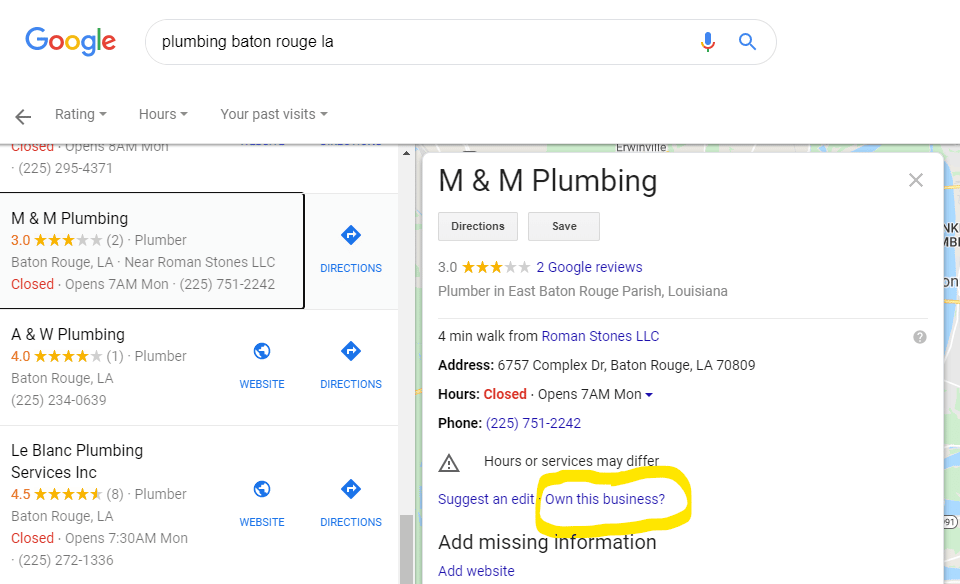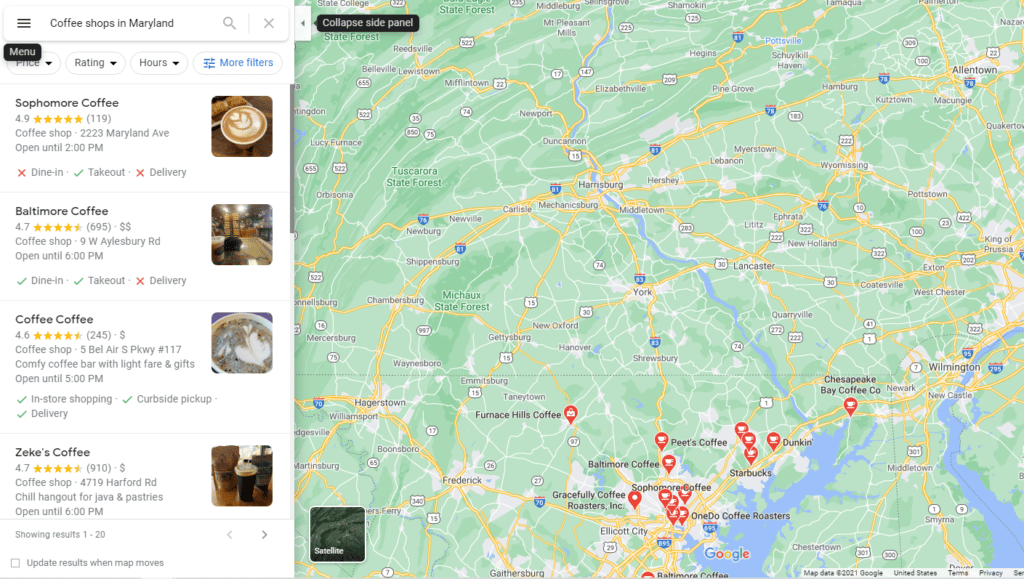Do you have a local business and you want to improve your ranking in Google maps, and in the search engines?
If your answer is yes. Then you clicked on the right link!
A HubSpot research show that, over 40% of all Google searches is local. Even with such number, a lot of local businesses, over 50%, haven’t claimed their spot on Google My Business listing.

The fact is, when you claim and optimize your Google My Business listing, you are well on your way optimizing for local SEO. While claiming and optimizing your listing on Google My Business is a great place to start, there is a lot more to local SEO.
What is local SEO?
Simply put, local SEO is optimizing your online presence so that you can be found by your target audience during localized searches. They are any type of search that is being localized, especially when they include a location. For example: ‘Coffee shops in Maryland’, ‘Coffee shops near me’, etc.

Using the information and tips in this guide, you can be sure that your business will come up on the front page of the search engines whenever a user searches a keyword related to your business.
Now, let look at the common places you want your business to show up.

The above image shows the ‘Local 3 pack’ or ‘Map pack’. The local 3 pack or map pack refers to the group of 3 businesses that show up in a box at the top SERPs just after the Ads. The three businesses usually come with their NAP data(name, address, phone), and reviews (if they have those).
Getting your business to show up on a spot like that would definitely get people clicking on your link, and consequently skyrocket your sales. To get there, you must optimize your business page on Google with the relevant keywords related to your business.
However, that’s not the only place that search is influenced by local SEO. It also affects searches on Google maps.

It also affects mobile results.

This is just trying to show you that local is everywhere! And, even if you own a brick and mortar store, or a service-based business, this guide will help you to show up everywhere you need to be during a local search.
What Influences Local SEO?
Local SEO can be divided into two parts:
- What influence the 3 pack rankings, and other map results?
- What influences organic listing rankings?
Now let’s take a look at what affect these rankings.
The Local SEO Pack / Map Rankings Factors
See this local SEO case study by Moz:

Looking the image above, it is obvious that the number one factor is My Business signals. What this means, is that, you need to properly optimize your Google My Business listing. (More on this later)
Looking further down the list (the image above), you can see that links are as important as on-Page signals from your website, citation signals, and reviews.
Map results were less influenced by your website’s ranking signals, but nowadays, they both work together. If your business isn’t ranking in Maps, it may mean that the signals to your website are weak. Therefore, you need stronger signals to your website.
Organic Listing / Website Ranking Factors

The number one ranking factor in the organic listing is Link signals. Links remains a vital part of ranking organically.
Going further down the list, you see On-page signals, behavioral signals, personalization, and NAP citation signals. All of these factors will be elaborated in this article.
Google My Business Optimization
Listing your business on Google My Business is the starting point for how your business data are displayed on Google in the Maps and knowledge graph.
In the Moz study, we mentioned that, Google My Business signals come up as the number one most important factor for ranking in the map results. If you don’t have a Google Business page, claim one now and optimize it.
Here’s how to go about it
The first step is to head to Google My Business page, and click Start Now.
Use your business domain email as your login (not, gmail.com or yahoo.com), for a more professional touch.
When you visit the page, you will be taken to a form where you will be required to enter your business information. Enter the NAP (Name, Address, and Phone Number) details displayed on your website.
Pay attention to the category section at the bottom of the form, because the right listing category will let customers (and Google bots) know exactly what your business is all about. This will enable your business to be displayed in the right search results.
Google allows you to use multiple categories. Take advantage of this and use as many as are relevant to your business. Try to be as specific as possible.
At this point, to make any further edits, you must verify your account.
There are three ways to go about the verification:
- Postcard: Google can send a verification code to the physical address you listed during the sign up.
- SMS: Google can send a verification code to your phone via an automated message.
- Email: If you use the same login details in your Google Search Console for you’re my Business account, a verification code can be sent to that business email.
Of all the options available, the most popular way is to receive a postcard in the mail. When filling out the rest of the form, after successful verification, ensure that you enter every detail in every section possible, including uploading photos.
After verifying and completing all the information for your Google My Business profile, the next step will be to move on to getting Local NAP Citations.
How To Get Local NAP Citations?
As you may already know, NAP stands for Name, Address, and Phone number. Now, here is why you need to get NAP citations on relevant directories around the web.
- Citation signals account for 13% of the ranking factors.
- Many people use these directories to search for businesses.
- The directories usually rank for localized terms.
- By creating a listing, you can also get a relevant link to your website.
As you can see, having a correct NAP citation is crucial. However, you should also know that citation inconsistency can cause ranking issues.
Your business can run into problems if something has changed about your NAP. At a time like this, ensure you do an audit to ensure that your citations are consistent.
Doing this is important because a citation is any online reference to your NAP. It doesn’t have to link to you, but Google evaluates them as a local signal to determine an entity’s online authority. Therefore, having an inaccurate and inconsistent NAP can negatively affect your local SEO.
Citation inconsistency is the number one problem affecting local SEO ranking. Having too many variations of your NAP scattered around the web, especially if some or all of them are outdated, makes it difficult for both customers and Google to trust your business. And, if Google thinks your business is untrustworthy, your local ranking will be downgraded. This isn’t something you want.
Audit and Optimize your business’s NAP Consistency
The best way to do a citation audit is to do it manually and uncover all listings and variations of your NAP. However, if you want to do a quick check, you can use Moz Local.
On the web page, you will be required to enter your business name, and your zip code, then click on Check my Business Listing.
What Moz Local does is that, it pulls up all the corresponding listings that is related to your website from the main local indexing platform and displays any inconsistencies it finds.
When these inconsistencies comes up, record them in a spreadsheet and make a note to contact the website owners to correct the NAP info with the one that’s consistent with the one you have.
The results that Moz presents to you, are only limited to the top indexing platforms that they have tagged. Therefore, it is possible that you may still have citations from other less authoritative or structured sources.
Those citations may have less impact, and it may take a whole lot of time to carry out a proper audit for every one of them. After you have audited your citations, the next thing would be to build citations.
How to Build NAP Citations
Businesses are different, therefore, you will need to create custom citations based on your industry and area. There are two good places to start when creating directory citations.
With these lists offered by Moz, you can find top directories that you should be listed based on your kind of business.
When you are building this list, ensure that you fully fill out the profile, which includes your business description, opening and closing hours, NAP, and more.
Local SEO On-Page Optimization
Optimizing your web pages is crucial to rank for the keyword your target audience is searching for. Here are eight things you should do to rank locally.
Structure Your Website to Rank Landing Pages
If your business serves multiple cities, create a city-specific landing page for each city. This is a common workaround for a business that has only one location, or does not have an office, but serves an entire area.
Set up your website to have multiple landing pages for each area you serve. Example;
Yourcoffeeshop.com/city-1
Yourcoffeeshop.com/city-2
Yourcoffeeshop.com/city-3
Yourcoffeeshop.com/city-4
This allows you to rank organically in places where you don’t have a physical office.
Optimize Your Titles, Meta Description, Headers and Content
All the usual On-Page optimization process applies here. Ensure that you include your city as well as your keywords in the title tag and on the page.
Present Your NAP in Schema Format on Your Website
Ensure that you display your name, address, and phone number combination on your website. Ensure that your NAP is consistent with your business listings. Remember to include your business hours.
Embed a Google Map
For users to easily locate your business, embed a Google map on your website.
Include Clear Calls to Action
No one creates a website for people to just visit and leave, you want them to convert. Ensure that your phone number is boldly displayed on your website. Guide your visitors around your website and use CTAs to tell them what to do next (It could be to call you, request a quote, submit their email, etc).
Include Reviews and Testimonials
When you include and testimonials on your website, it gives users confidence in your service and business. This will help improve conversions.
Make it Mobile Friendly
Google tends to favor mobile friendly websites. Use Google’s Mobile friendly test to ensure that your website displays correctly on mobile devices.
Local Link Building
Getting backlinks to your website is just as important with local SEO as it is with any other type of SEO; and many of the same techniques work here. And this includes the need to publish relevant and educative content for your audience, promote influencers, guest post on other blogs, and get links to relevant resource listings.
The difference between local link building and the general link building is its specificity. For your local link building, aim to place your links in a more locally targeted resource listings and blogs.
Finding local listings to get linked to
Whitespark created a list of the top 50 local citation sites by country that you can refer to. If that list doesn’t cover everything you need, you can also find more local leads by searching Google.
You can use this combination of queries you can use for business listings and directories:
[location] business listings [location] business directory [location] directory [business type keyword] business listings [location] [business type keyword] business directory [location] [business type keyword] directory [location]For trade organizations:
[location] [business type keyword] alliance [location] [business type keyword] association [location] [business type keyword] council [location] [business type keyword] societyStrategies to get local links
Get the results of your search into a spreadsheet and arrange them in order of priority – which ones to connect with first, depending on their relevance and influence.
- Get your business listed in the most relevant business directories.
- Join active, massive, trade-based organizations related to your business.
- Partner with charities, non-profit organizations, or schools.
- Participate in or spearhead community events.
- Start a mentoring program. It could be for the community or for local schools in your area.
- Try to get speaking assignments at events relating to your industry.
When you do any of these things, pitch the announcement or story to your local newspaper.
Here is a local link building case study cited on Moz, where a business owner opened a local scholarship, and got featured in their local paper, and even got backlinks from the Wall Street Journal.
Participating actively in these local events will not only give your local SEO a boost, it will also increase your local visibility, and, if you deliver your projects right, boost your reputation within your local community.
How to Get Local Reviews?
Boost your business’s local reputation by getting more positive reviews. Which coffee shop would you rather go? Shop A, with no online profile, a 2-star rated coffee shop filled with dissatisfied customer testimonial / review, or Shop B, with a 4.8-star rated shop filled with hundreds of reviews? Let me guess, Shop B!
According to a recent survey, about 87% of people trust online review as much as personal recommendations. However, the power of reviews doesn’t end there. The reviews also help to drive search rankings up.
Another survey by a marketing resources revealed that having reviews on your sales page can increase conversions by 18%.
When your online reputation is boosted, you get three crucial benefits to boost your local SEO – a vote of consumer trust, a boost in search rankings, and a chance for increased conversions.
Knowing the importance of including reviews to your local SEO, let’s show you how to go about it.
Claim Your Business Profile On Top Review Sites
Register your business on top review sites. Here is a list of top 19 consumer review sites as published by HubSpot, including, Yelp, Google My Business reviews, TripAdvisor, Better Business Bureau, and Amazon, among others.
Find out which of these sites brings you the most value. For example, if your business is housing, Zillow is your best option, for a restaurant business, TripAdvisor is the place to be.
For Google and Facebook, once you have your business accounts set up, the review process is as simple as customers leaving comments on your business page. And for Yelp, you can easily claim a business page by entering your business name and address.
It may take some time before Yelp moderators verify your business, but after that, you will get an email for a verified account.
The verification is important because it lets you edit your business information and you can respond to any user reviews.
Now that you have set up a business profile, it is now time to build up your online reputation.
Get More Quality Reviews for Your Business
Getting a substantial amount of quality reviews isn’t difficult, if you have a system in place. Here is how you can go about it:
- You can get positive reviews through review-promoting widgets, email autoresponders, and email signatures, then incentivise these to encourage more.
- Resolve the negative reviews before they go out by redirecting lower-star reviews to customer service.
A lot of people are influenced by positive online reviews before they make a purchase. The more quality, positive reviews you get on your website, the higher the chances are of convincing customers to patronize your business. Remember to prominently display these reviews on your website.
Armed with this powerful information contained in this article, you can upscale your local business, and see a good ROI within a short period of time.
Good Luck!
